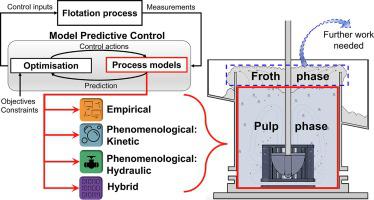Minerals Engineering ( IF 4.9 ) Pub Date : 2020-12-29 , DOI: 10.1016/j.mineng.2020.106718 Paulina Quintanilla , Stephen J. Neethling , Pablo R. Brito-Parada

|
Flotation is a conceptually simple operation; however, as a multiphase process with inherent instability, it exhibits complex dynamics. One of the most efficient ways to increase flotation performance is by implementing advanced controllers, such as Model Predictive Control (MPC). This type of controller is very dependent on the model that represents the dynamics of the process. Although model development is one of the most crucial parts in MPC, flotation models have been mainly developed for simulation purposes (i.e. analysis and design) rather than control purposes. This paper presents a critical literature review on modelling for froth flotation control. Models reviewed have been sub-classified as empirical, phenomenological and hybrid according to their characteristics. In particular, it is highlighted that models have so far primarily focused on the pulp phase, with the froth phase often neglected; when the froth phase is included, kinetics models such as those used for the pulp phase, are commonly used to represent it. Froth physics are, however, dominated by processes such as coalescence, liquid motion and solids motion, which have been previously modelled through complex, steady-state models used for simulation purposes, rather than control purposes. There remains a need to develop appropriate models for the froth phase and more complex models for the pulp phase that can be used as part of MPC strategies. The challenges associated with the development of such models are discussed, with the aim of providing a pathway towards better controlled froth flotation circuits.
中文翻译:

泡沫浮选控制建模:综述
浮选在概念上很简单;然而,作为具有固有不稳定性的多相过程,它表现出复杂的动力学。提高浮选性能的最有效方法之一是实施高级控制器,例如模型预测控制(MPC)。这种类型的控制器非常依赖于表示过程动态的模型。尽管模型开发是MPC中最关键的部分之一,但浮选模型的开发主要是出于仿真目的(即分析和设计),而不是出于控制目的。本文提出了有关泡沫浮选控制模型的重要文献综述。所审查的模型根据其特征已分为实证模型,现象模型和混合模型。特别是,需要强调的是,到目前为止,模型主要集中在纸浆相,而泡沫相通常被忽略。当包含泡沫相时,通常使用动力学模型(如纸浆相模型)来表示它。但是,泡沫物理学主要由诸如聚结,液体运动和固体运动之类的过程控制,这些过程先前已通过用于仿真目的而非控制目的的复杂的稳态模型进行了建模。仍然需要为泡沫相开发适当的模型,并为纸浆相开发更复杂的模型,这些模型可以用作MPC策略的一部分。讨论了与此类模型开发相关的挑战,目的是提供一条通向更好控制的泡沫浮选回路的途径。当包含泡沫相时,通常使用动力学模型(如纸浆相模型)来表示它。但是,泡沫物理学主要由诸如聚结,液体运动和固体运动之类的过程控制,这些过程先前已通过用于仿真目的而非控制目的的复杂的稳态模型进行了建模。仍然需要为泡沫相开发适当的模型,并为纸浆相开发更复杂的模型,这些模型可以用作MPC策略的一部分。讨论了与此类模型开发相关的挑战,目的是提供一条通向更好控制的泡沫浮选回路的途径。当包含泡沫相时,通常使用动力学模型(如纸浆相模型)来表示它。但是,泡沫物理学主要由诸如聚结,液体运动和固体运动之类的过程控制,这些过程先前已通过用于仿真目的而非控制目的的复杂的稳态模型进行了建模。仍然需要为泡沫相开发适当的模型,并为纸浆相开发更复杂的模型,这些模型可以用作MPC策略的一部分。讨论了与此类模型开发相关的挑战,目的是提供一条通向更好控制的泡沫浮选回路的途径。由诸如聚结,液体运动和固体运动之类的过程控制,这些过程先前已通过用于仿真目的而非控制目的的复杂的稳态模型进行了建模。仍然需要为泡沫相开发适当的模型,并为纸浆相开发更复杂的模型,这些模型可以用作MPC策略的一部分。讨论了与此类模型开发相关的挑战,目的是提供一条通向更好控制的泡沫浮选回路的途径。由诸如聚结,液体运动和固体运动之类的过程控制,这些过程先前已通过用于仿真目的而非控制目的的复杂的稳态模型进行了建模。仍然需要为泡沫相开发适当的模型,并为纸浆相开发更复杂的模型,这些模型可以用作MPC策略的一部分。讨论了与此类模型开发相关的挑战,目的是提供一条通向更好控制的泡沫浮选回路的途径。仍然需要为泡沫相开发适当的模型,并为纸浆相开发更复杂的模型,这些模型可以用作MPC策略的一部分。讨论了与此类模型开发相关的挑战,目的是提供一条通向更好控制的泡沫浮选回路的途径。仍然需要为泡沫相开发适当的模型,并为纸浆相开发更复杂的模型,这些模型可以用作MPC策略的一部分。讨论了与此类模型开发相关的挑战,目的是提供一条通向更好控制的泡沫浮选回路的途径。











































 京公网安备 11010802027423号
京公网安备 11010802027423号